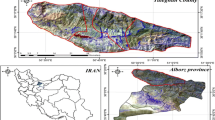Abstract
This paper reports about uncertainty in defining boundaries, which assume an institutional significance when transposed in planning prescription. Every discipline involved in environmental planning uses different approaches to represent its own vision of reality. Geological sciences or hydraulics evaluate risks by consistent mathematical models which are relevantly different to non linear models emploied in the field of ecology, and at the same time information about significance and value of cultural heritage in a given environment does not easily correspond to a value attribution. These questions represent an interesting field of research, related with the different character of information deriving from different disciplinary approaches, and with the more appropriate way of combining the same information. Different ways of managing values correspond to different ways of giving information. The result is a set of discrete representations of the physical space which correspond to a set of different values referring to areas which are considered homogeneous according to each disciplinary point of view, but very difficult to combine to create landscape units according to the whole of disciplines. The present paper illustrates a reflection on a G.I.S. application in a land suitability study on a sub-regional area of Southern Italy. Emerging questions are related to the need to combine contributions of all environmental information which are represented at different scales, with different interpretative models, with different precision of identification of landscape unit, etc.
Access this chapter
Tax calculation will be finalised at checkout
Purchases are for personal use only
Preview
Unable to display preview. Download preview PDF.
Similar content being viewed by others
References
McHarg, I.L.: Design with Nature. The Natural History Press, Garden City (1969)
Malczewski, J.: Gis and Multicriteria Decision Analysis. John Willey & Sons Incorporated, Toronto (1999)
Couclelis, H.: Towards an Operational Typology of Geographic entities with ill-defined boundaries. In: Burrough, P.A., Frank, A.U. (eds.) Geographic Objects With Indeterminate Boundaries, pp. 45–55. Taylor and Francis, London (1996)
Leung, Y.: Spatial analysis and planning under imprecision. Elsevier Science Publishers, Amsterdam (1988)
Jawahar, C.V., Biswas, P.K., Ray, A.K.: Investigation on fuzzy tresholding based on fuzzy clustering. Pattern Recognition 30(10), 1605–1613 (1997)
Zadeh, L.A.: Outline of a new approach to the analysis of complex systems and decision processes. IEEE Trans. On Systems, Man, Cybernet 3(1), 28–44 (1973)
Cheng, T., Molenaar, M., Lin, H.: Formalizing fuzzy object uncertain classification results. International Journal of Geographical Science 15(1), 27–42 (2001)
Molenaar, M.: An Introduction to the Theory of Spatial Object Modelling for GIS. Taylor & Francis, London (1998)
Zhang, J., Goodchild, M.F.: Uncertanty in geographic information. Taylor and Francis, London (2002)
Johnston, K.M.: Geoprocessing and Geographic Information System Hardware and Software: Looking towards the 1990’s. In: Sholten, H.J., Stillwell, J.C.H. (eds.) Geographical Information System for Urban and Regional Planners, pp. 215–227. Kluwer Academic Publisher, Dordrecht (1990)
Couclelis, H.: People manipulate objects (but cultivate fields): beyond the raster-vector debate in GIS. In: Frank, A.U., Campari, I., Formentini, U. (eds.) Theories and Methods of Spatio-temporal Reasoning in Geographic Space. Computer Science, pp. 45–55. Springer, Berlin (1992)
Burrough Peter, A., Frank Andrew, U. (eds.): Geographic Objects With Indeterminate Boundaries. Taylor and Francis, London (1996)
Author information
Authors and Affiliations
Editor information
Editors and Affiliations
Rights and permissions
Copyright information
© 2004 Springer-Verlag Berlin Heidelberg
About this paper
Cite this paper
Murgante, B., Casas, G.L. (2004). G.I.S. and Fuzzy Sets for the Land Suitability Analysis. In: Laganá, A., Gavrilova, M.L., Kumar, V., Mun, Y., Tan, C.J.K., Gervasi, O. (eds) Computational Science and Its Applications – ICCSA 2004. ICCSA 2004. Lecture Notes in Computer Science, vol 3044. Springer, Berlin, Heidelberg. https://doi.org/10.1007/978-3-540-24709-8_109
Download citation
DOI: https://doi.org/10.1007/978-3-540-24709-8_109
Publisher Name: Springer, Berlin, Heidelberg
Print ISBN: 978-3-540-22056-5
Online ISBN: 978-3-540-24709-8
eBook Packages: Springer Book Archive





